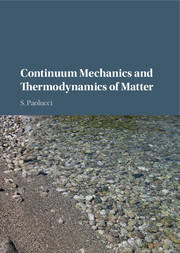5 - Principles of constitutive theory
Published online by Cambridge University Press: 05 February 2016
Summary
Conservation of mass, the balance of linear momentum, the balance of angular momentum, the balance of energy, and the entropy inequality are valid for all continuous media. However, different material bodies having the same mass and geometry, when subjected to identical external effects, respond differently. The internal constitution of matter is responsible for the different responses. To understand these differences, we need equations that reflect structural differences between materials. This is the subject of constitutive theory. Constitutive relations can be regarded as mathematical models for material bodies, and as such, they define ideal materials. Since real materials always contain irregularities and defects, the validity of a model should be verified through experiments on the results it predicts. On the contrary, some experiments may suggest certain functional dependence of the constitutive relations on its variables to within a reasonable satisfaction for certain materials. However, experiments alone are rarely, if ever, sufficient to determine constitutive relations of a material body.
There are some universal requirements that a model should obey lest its consequences be contradictory to some well-known physical experience. Therefore, in search of a correct formulation of a mathematical model, in general, we shall first impose these requirements on the proposed model. The most important universal requirements of this kind are:
• Principle of causality: causality describes the relationship between causes and effects as governed by the laws of nature. In classical physics, we assume that a cause should always precede its effect; i.e., the cause and its effect are separated by a time interval, and the effect belongs to the future of its cause.
• Principle of equipresence: all constitutive functions should be expressed in terms of the same set of independent constitutive variables until the contrary is deduced.
• Principle of frame indifference: the constitutive equations must be objective with respect to Euclidean motions of the spatial frame of reference – they must be the same as seen from inertial and non-inertial frames of reference.
• Principles of material smoothness and memory: the constitutive functions at regular points should be spatially and temporally smooth so that material gradients and time derivatives up to some orders exist.
• Principle of material symmetry: a body subjected to the same thermomechanical history at two different configurations in general have different results.
- Type
- Chapter
- Information
- Continuum Mechanics and Thermodynamics of Matter , pp. 191 - 270Publisher: Cambridge University PressPrint publication year: 2016
References
- 1
- Cited by



